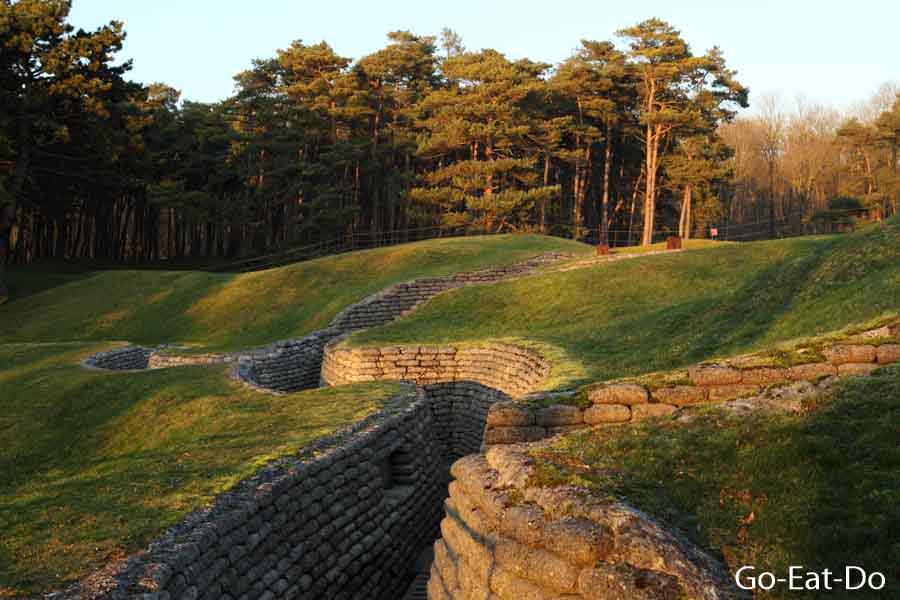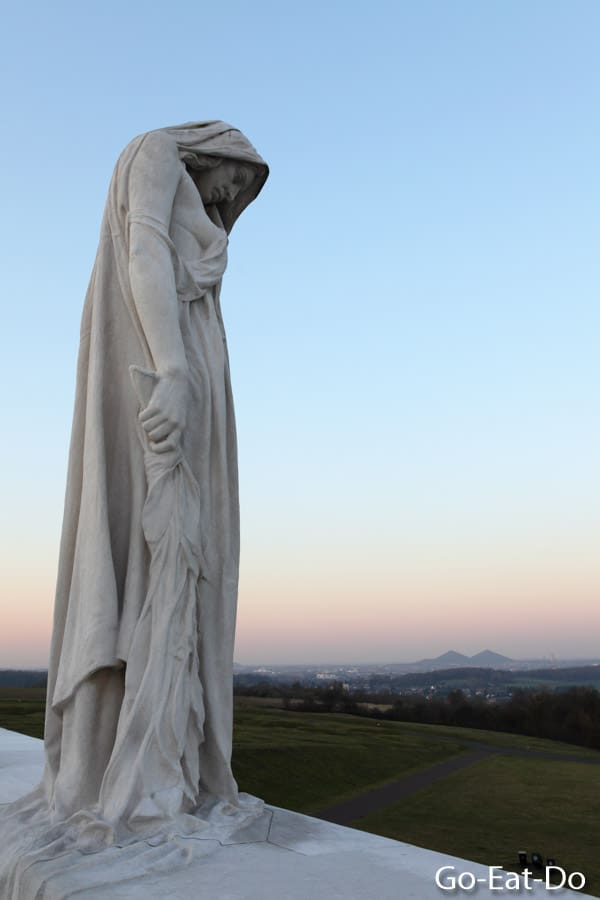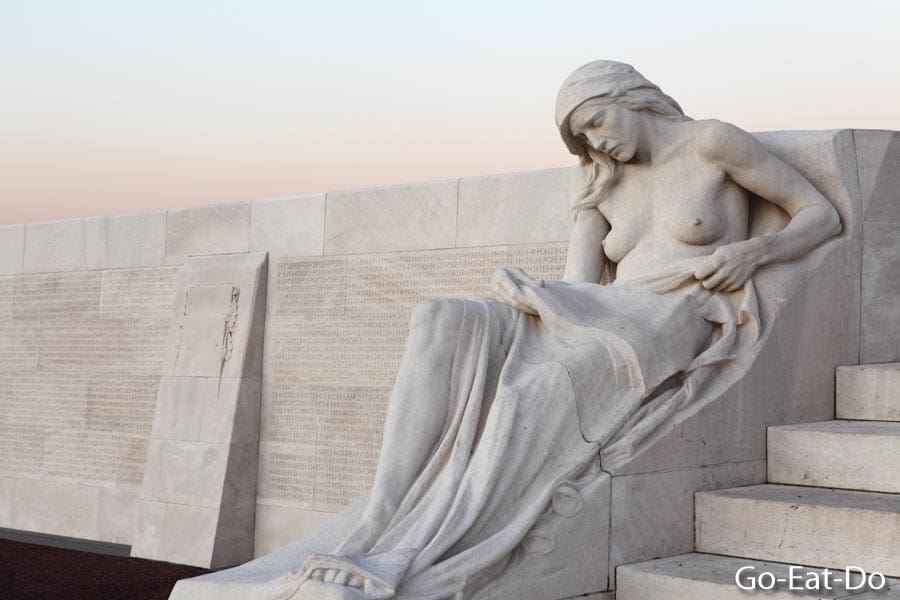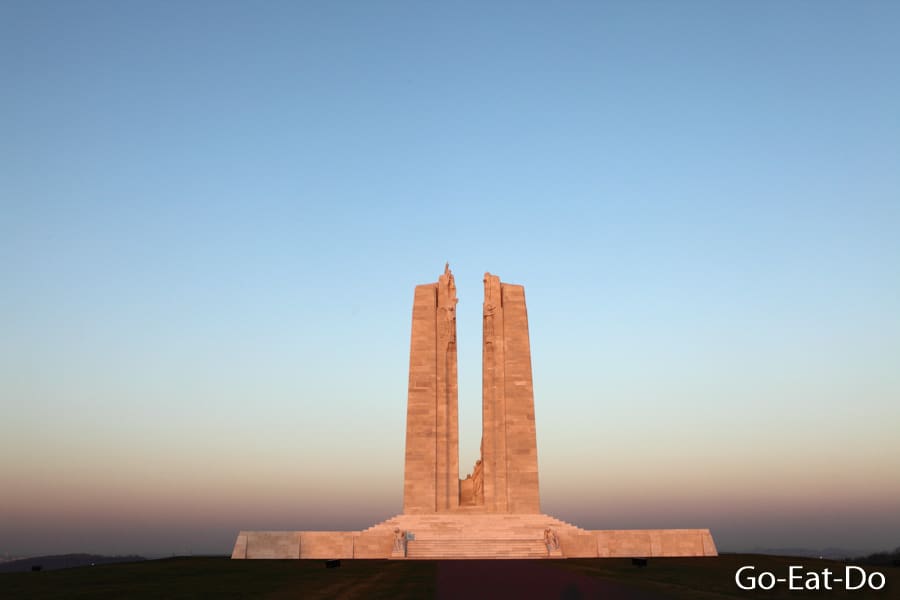Stuart Forster visits the Canadian National Vimy Memorial in northern France.
It’s a bright January day and icy wind whips across the hill topped by the Canadian National Vimy Memorial in northern France. I crouch by the monument to zip up my coat. A century ago hot shrapnel rather than cold air was ripping across this ridge overlooking the Douai Plain.
The discomfort that I’m feeling is temporary. In an hour or so I’ll be back inside of a heated vehicle. One hundred years ago the men advancing on Vimy Ridge had few places shelter — the blasts they faced were potentially deadly rather than merely discomforting.
The Battle of Arras
On 9 April 1917 four divisions of the Canadian Corps advanced on the opening day of the Battle of Arras. For the first time, units from the Dominion of Canada were fighting side by side.
Their objective was to secure the strategically important high ground, 60 metres above the surrounding plain. From Vimy Ridge German artillery had been raining shells onto trenches and the city of Arras, eight kilometres to the south.
It was captured on the first day of the Battle of Vimy Ridge, which lasted until 12 April 1917, as part of a wider, British-led offensive which ground on into mid-May. Both sides amassed well in excess of 100,000 casualties during the Battle of Arras.
Ahead of the fighting, soldiers massed in tunnels that were mined into the region’s chalky ground at a rate of six metres a day. Maple leaves carved into the tunnel walls are regarded evidence of the sense of national identity that grew among the Canadian soldiers fighting on the Western Front.

Canada in World War One
The Vimy Memorial bears the name of 11,285 Canadian soldiers who were killed in action during the Great War and have no known resting place. In total, more than 60,000 Canadians died and almost three times that number suffered physical wounds at the front. An unknown number would have returned home traumatised.

A female figure with a bowed head, depicting Canada grieving her losses, stands as part of the monument designed and sculpted by Walter Seymour Allward. King Edward VIII unveiled the memorial on 26 July 1936.

My guide is a Canadian student, a volunteer who explains that the 100-hectare site of the memorial has been dedicated to Canada in perpetuity.
Frontline trenches and Grange Tunnel
I’m part of a group that is also led through a section of well-maintained frontline trenches. To my surprise, Allied and German trenches were, at points, separated by just a few metres of No-Man’s Land.
The zig-zag form of the trenches helped limit the number of casualties inflicted if a section of the line took a direct hit by a high-explosive shell.
In places the green, artillery churned landscape reminds me of moguls between ski slopes. A century has passed yet the earth stills bears the scars of warfare.

Dipping down, we enter Grange Tunnel, which runs for around a kilometre and reaches to a depth of ten metres. It was one of 13 tunnels that enabled men and materials to be moved to the frontline.
Wooden supports within the tunnel date from the war though the concrete walls were erected during subsequent reconstruction. Looking up, I spot rusted wires and ceramic insulators that are a legacy of the telephone lines that enabled rapid communications during the battle. Runners were quartered in the tunnel, in case a manual method of conveying information was required.
Prior to the offensive launched on 9 April 1917 around one million Allied troops amassed along the 20-kilometre front of the Battle of Arras. The first wave of fighting at Vimy Ridge, beginning at 5.30am, saw 20,000 Canadian troops advance.
Standing at the well-maintained site it’s hard to envisage that they pressed forward through mud and water that reached to their knees. Under the eerie light of a bright but bitterly cold afternoon it’s impossible for me to imagine the noise, suffering and horror of warfare endured by troops at Vimy Ridge.
This is a site of national significance to Canada and of historic importance to humanity.

Further information
The Canadian National Vimy Memorial (Chemin des canadiens (Route D55), 62580 Vimy; tel. +33 (0) 3 2150 6868) is open throughout the year, seven days a week. It is open from 9am (11am on Mondays) until 5pm. The site includes the Vimy Memorial, cemeteries, a network of frontline trenches plus a new Visitor Education Centre. Visiting is free-of-charge.
The Vimy Memorial is in the Hauts-de-France region of north-east France, 110 kilometres south-east of Calais — a drive of around 75 minutes.
See the Atout-France website for information on places of interest throughout France.
Photos illustrating this post are by Why Eye Photography.
If you enjoyed this post why not sign up for the free Go Eat Do newsletter? It’s a hassle-free way of getting links to posts on a monthly basis.
‘Like’ the Go Eat Do Facebook page to see more photos and content.
The Visitor Education Centre
A new visitor centre opened to the public on 9 April 2017. It commemorates Canadian participation in the First World War and the Battle of Vimy Ridge, during which four Canadian soldiers were awarded the Victoria Cross.
Artefacts on display include a cross from the Battle of Vimy Ridge bearing the 57 names of the soldiers from the 15th Battalion — the 48th Highlanders of Canada — killed in action plus tools used in sculpting the memorial. Wartime graffiti, from nearby tunnels, will be displayed until November 2017.




Laura
April 12, 2017 at 17:26What an interesting and informative post, thanks for sharing this! I love France and enjoy finding unique historic places to visit anywhere in the world.
Laura xo
Stuart Forster
April 13, 2017 at 13:50Thank you. There are certainly many historic and interesting spots around Calais and Arras.